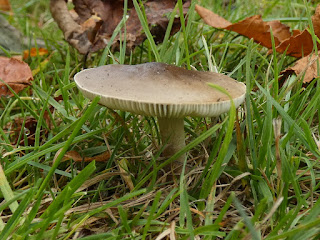Carrion Crows have become adept adept at stealing the apples people put out for the Rose-Ringed Parakeets.
A Blue Tit ...
... and a Great Tit came out to be fed near the bridge.
A Starling shone in the sunlight as it drank at the edge of the Serpentine.
A pair of Feral Pigeons canoodled on the landing stage.
A Wood Pigeon bathed in the pool at the top of the Dell waterfall.
A Cormorant had a wash on the Long Water.
A Herring Gull tried to stand on one of the plastic buoys at the Lido, and as usual the buoy revolved and tipped it off.
The youngest Great Crested Grebe chicks on the Long Water pestered their parents to catch fish for them.
A Moorhen parent watched a teenager cross the small waterfall in the Dell.
The female Wigeon the the Serpentine, a completely wild bird when she arrived eleven days ago, is now as fearless as one of the familiar park Mallards.
One of the Bar-Headed x Greylag Goose hybrids from St James's Park visited the Serpentine.
A late Speckled Wood butterfly perched on a bramble beside the Long Water.
I hadn't seen any Honeybees for some time, but there was one on the plumbago in the Rose Garden.
The mystery hoverfly was there too, and at last showed its face. From Conehead 54's information, the black inverted Y-shaped mark on its forehead indicates that it's Eupeodes luniger. It's female; males have bigger eyes that come closer together.
Another unknown species: this solitary mushroom on Buck Hill is about 2 inches across.
I think this beautiful yellow tree between the Rose Garden and the Dell is a Black Walnut.














What is the Canadian in the Wigeon video doing? The Swan appears to be bothering it.
ReplyDeleteThe Wigeon is a lovely bird. She is so light and airy and graceful.
Someone was feeding the birds, so there was a mob at the edge of the lake. Swans often peck geese out of the way at these times, and indeed often go for subordinate swans too. The Wigeon was doing very well, dodging in and out of the brawl.
DeleteInteresting to watch the behaviour of the Wigeon. It's surprising to see one on it's own as outside the breeding season they are such gregarious flocks, often encountered in very large flocks in favoured locations. I guess Rainham would be the top site where several hundred can be seen in the winter & the London Wetland Centre regularly gets 80 or so.
ReplyDeleteCertainly a very tame bird but birds seem to soon learn where humans are not a threat. In the wider countryside it's a popular quarry target by wildfowlers so pays to be wary on sites where shooting occurs. Maybe she'll bring some friends if she returns next year?
I don't think the Wigeon will come back. We have a history of vagrant ducks, most recently a Scaup and a Goldeneye, which have stayed for a few weeks and then flown away never to be seen again.
DeleteCanoodled!!
ReplyDeleteHaven't heard that word in ages.
It seemed to fit.
Delete